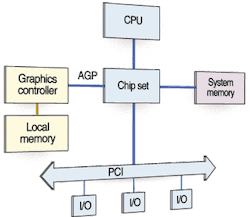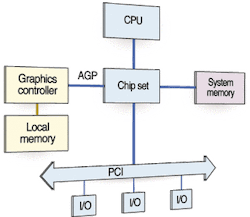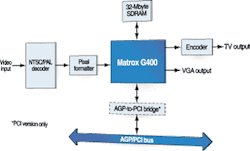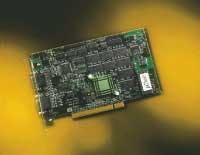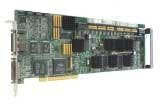PCI-based boards add VGA display
By Andrew Wilson, Editor
Many industrial machine-vision and image-processing applications require real-time display as images are captured. Frame-grabber vendors are meeting this system-integration need by developing boards that can transfer data over the Peripheral Component Interface (PCI) bus into VGA-based graphics cards for display. Although this approach allows systems integrators to choose the latest VGA display controller card, it increases bus traffic, which could result in increased latency and impact real-time machine-vision performance. Accordingly, some frame-grabber vendors have implemented a display controller directly on their boards. In this way, images can be digitized and processed, and the results of such processing can be delivered, often in SVGA format, directly to the system monitor.
"There is a large class of applications that require live images to be displayed on the desktop," says Philip Colet, vice president of sales and marketing at Coreco Imaging (St-Laurent, QC, Canada). "These include medical visualization, video surveillance, and some industrial machine-vision applications."
PCI vs. AGP
For such applications, systems developers can choose from a number of frame grabbers and display controllers implemented on either the PCI or Accelerated Graphics Port (AGP) bus. Because today's PCI-based machine-vision and image-processing systems can use several PCI-based peripherals, such as disk controllers, networking boards, and data-acquisition peripherals, choosing an AGP-based frame grabber/display controller can result in less PCI bus congestion.
"Our customers prefer to use frame grabbers with an integrated display when they are trying to conserve the host bandwidth," says Fabio Perelli, product manager of frame grabbers and stand-alone systems at Matrox Imaging (Dorval, QC, Canada). "In addition, those who are using these frame grabbers for machine-vision applications are usually planning for the long term and don't have the same requirements as those in the video-gaming industry," he explains.
Because the AGP bus operates concurrently with, and independently of, most transactions on the PCI bus, CPU accesses to system memory can proceed concurrently with AGP memory reads by the graphics controller. And, the AGP bus is not limited by the 132-Mbyte/s bandwidth that the PCI bus delivers. According to Intel Corp. (Santa Clara, CA), more than 2.1 Gbytes/s of peak bandwidth can be achieved using the AGP bus.
Developed primarily for graphics applications that require fast texture mapping, the AGP bus allows direct execution of texture maps from system memory. It enables direct access to system memory by the graphics controller, rather than forcing it to preload the texture data into local video memory (see Fig. 1). This architecture removes traffic from the PCI bus, allows more textures than can typically fit into local memory to be used for greater detailed images and texture maps, and reduces the local memory requirements on the graphics card.
null
Physically, the AGP interface is a point-to-point topology that uses 1.5- or 3.3-V signaling and one of four clock speeds. The minimum baseline standard uses a 66-MHz clock that provides a peak bandwidth of 266 Mbytes/s. The AGP 2x mode doubles this clock speed for a peak bandwidth of 533 Mbytes/s. Likewise, AGP 4x mode features a peak bandwidth of 1066 Mbytes/s and AGP 8x mode features a 2.1-Gbyte/s peak bandwidth. Both Coreco Imaging and Matrox Imaging offer both PCI- and AGP-based frame-grabber/display-controller boards.
Boards galore
Coreco Imaging offers a number of different frame grabbers under its Bandit-II brand: Bandit-II CV, Bandit-II MV, Bandit-II RGB, and Bandit-II Digital. The input sections of each board offer different methods of image digitization such as color S-video, NTSC, and PAL (CV board); progressive-scan cameras (MV board); RGB, composite, or S-video (RGB board); and single or dual-tap LVDS area-scan cameras (digital board).
For display control, however, each Bandit-II design uses an on-board VGA controller that can display resolutions up to 1600 × 1200 pixels and refresh rates of up to 100 Hz. Because the graphics chip supports an integrated dual-head display capability, images can be displayed in both VGA and VGA-plus composite video simultaneously. Therefore, the secondary VGA and composite video outputs can be configured to display live images with a graphics overlay or can duplicate the contents of the primary VGA display. All Bandit-II boards support the AGP 1x, 2x, and 4x standards or can be supplied with Rev 2.1 of the PCI bus.
Matrox Imaging also offers a number of products that feature on-board display controllers, including the Orion, a standards-based RS-170/composite/S-video/NTSC frame grabber/display controller. The Orion is available in AGP and PCI versions and supports either the 33-MHz/32-bit PCI bus or AGP versions 1x and 2x. Rather than implement 1280 × 1024-pixel VGA resolution using an off-the-shelf graphics chip from companies such as S3 Graphics (Fremont, CA), Matrox has leveraged the expertise of its graphics-products division and placed the Matrox G400 graphics controller on the board (see Fig. 2). By using this device in conjunction with an NTSC/PAL video encoder, captured images can be displayed as VGA and composite-video images.
null
Despite the adoption of the 8x AGP by many major graphics-board vendors, this standard has not yet been adopted by frame-grabber/display-controller vendors. "Currently we have no plans to implement 8x AGP in our design," says Coreco Imaging's Colet. "The importance for 8x AGP is predominately for very-high-speed graphics reads from host memory (such as for 3-D applications), which are not typically found in machine-vision applications," he says. Matrox declined to comment on whether its future boards would incorporate the 8x AGP.
Off-the-shelf display
Matrox is the only company currently using its own graphics controller for image and graphics display in a combined frame-grabber/display-controller design. To implement similar designs, other companies, such as Alacron (Nashua, NH), MuTech (Billerica, MA), and The Titan Corp. (San Diego, CA), use off-the shelf display controllers from third-party vendors. Here, the most popular graphics controller is the Savage Series from S3 Graphics. Built as a graphics chip for high-volume, low-cost PCI- and AGP-based graphics cards, these devices feature a pipelined graphics-rendering engine that can support a number of display and AGP modes, depending on which device is used.
The Image/VGA-410 from MuTech, for example, is a PCI-based board that contains an integrated frame grabber based on the SAA7114 digitizer from Phillips Electronics (Eindhoven, The Netherlands) and the 128-bit, 3-D Savage Pro accelerated VGA display controller from S3 Electronics. Using the VGA-410 board, composite NTSC, PAL, and S-Video images can be digitized and displayed in real time inside a resizable video window on the computer's VGA monitor (see Fig. 3). Text and graphics can be written into the VGA memory and, using a color key, overlaid nondestructively on top of the live video. Resolutions, with a live video window, of up to 1280 × 1024 × 32 bits are supported, and both VGA graphics and video can have different pixel depths.
null
The design of the Titan's VigraVision 4 PCI-STD and PCI-Pro boards is similar to MuTech's VGA-410 board. Instead of using the Philips SAA7114 digitizer to capture NTSC, PAL, and S-Video signals, however, Titan's designers opted for the similar SAA7111A digitizer. In addition, the board provides a 16-bit digital I/O port that interfaces RS-422 or LVDS cameras to the board. After images are digitized, they are passed directly to a S3 Savage-4 graphics controller (on the PCI-STD board) or through an FPGA-based image-processing stage to the display controller (on the PCI-Pro board). With display resolutions to 1600 × 1200 × 24 bits at 85-Hz refresh rates, the board can provide both VGA and NTSC/S-Video/PAL outputs simultaneously, allowing the configuration of dual monitor systems.
In the fast-paced technology of PC graphics, however, the graphics devices used in most imaging boards have already been superceded by later devices. Matrox, for example, is already offering a graphics board based on its G550 graphics chip. Its Millennium G550 card uses the device to support AGP data rates of 1x, 2x, and 4x. Other manufacturers, such as Nvidia (Santa Clara, CA), are targeting even faster AGP data rates. Its latest Quadro FX Workstation Graphics Processing Unit, for example, provides 128-bit floating-point precision, eight programmable pixel pipelines, and 400-MHz RAMDACs to drive QXGA displays at AGP rates as fast as API 8x. The latest S3 device, the DeltaChrome, is claimed to include a V8, 8-pixel pipelined, 3-D engine running at a 2.4-Gpixel/s fill rate, a hardware implementation of DirectX 9.0, and a high-definition video encoder that can support up to 1080 horizontal lines of resolution in progressive mode.
Applications such as real-time medical visualization mandate other types of designs. In 1999, TeraRecon (San Mateo, CA) introduced the VolumePro 500, a PCI-based add-in board that computes volume rendering at 30 frames/s (see Vision Systems Design, July 1999, p. 9). At last December's Radiological Society of North America show, the company introduced its latest version, the VolumePro 1000, a real-time 3-D PCI-based visualization system capable of supporting up to 1 Gbyte of volume memory.
As TeraRecon pointed out when its first products were introduced, polygon rendering uses vastly different operations than volume rendering because it starts from a geometric description of objects. In a geometric computer-aided-design description of an object, operations include 3-D transformations, rasterizing, Gouraud shading, and texture mapping. Volume rendering, however, begins with a sampled representation of objects and requires stepping through the volume data, data interpolation, estimation of gradients or surface normals, assigning color to samples, shading, and compositing samples into a pixel. As a result, the company did not use an off-the-shelf graphics controller; instead, it chose its own custom processor built especially for volume-rendering applications.
Decoupled graphics
Although low-cost frame grabber/display controllers are often limited to composite video input and VGA and video displays, more-expensive products can interface to several other standards, including composite video, RS-422, and Channel Link. To do this, however, developers have turned to a decoupled approach in their designs and used on-board secondary buses to tie together the input, processing, and display functions. Such designs include the FastImage 1300 multiprocessor board from Alacron and the Genesis board from Matrox.
Although the designs differ architecturally, both boards couple the frame-grabbing, processing, and display functions through the use of a secondary bus. In the FastImage 1300 Series, for example, a secondary 32-bit/33-MHz bus is used to interface up to four Philips TriMedia devices with an S3 graphics controller that provides continuous composite NTSC/PAL and SVGA video outputs. An on-board input section captures a variety of inputs, including composite color video, three channels of analog video input, and digital video, at up to 40 Mbytes/s (see Fig. 4).
null
The Matrox Genesis board also handles different types of camera inputs, including double-speed progressive-scan cameras with single or dual video outputs, color and monochrome linescan cameras, and high-rate analog or digital video at up to 140 MHz. Genesis features a baseboard processor that hosts a TMSC80 processor, a neighborhood operations accelerator, optional mezzanine grab modules, and a display controller. Like the Oasis board, the Genesis board also uses a custom-built Matrox graphics controller—this time, an MGA 2064W graphics accelerator for graphics overlay onto image memory.
In many image-processing and machine-vision applications, the use of embedded graphics features, such as fast polygon drawing speeds, hardware-based antialiasing, and 12-bit subpixel precision, are irrelevant. "Phong and Gouraud shading, as well as sophisticated texture mapping, are techniques used for rendering 3-D triangular mesh models, such as those used by the gaming and entertainment industries, and do not have much use in machine-vision applications," says Irene Leszkowicz, interactive software leader at Matrox Imaging. "However, in many industrial vision applications, off-loading of the system bus is crucial; so while the 3-D pipeline may not be used, the graphics processor's high-bandwidth data paths from memory to display are still required."
Click here to view Frame Grabber Boards with Display Capability
16k PDF will open in new window.
Company Information
Intel Corp.
Santa Clara, CA, USA
www.intel.com
Nvidia
Santa Clara, CA, USA
www.nvidia.com
Philips Electronics
Eindhoven, The Netherlands
www.philips.com
S3 Graphics
Fremont, CA, USA
www.s3graphics.com
